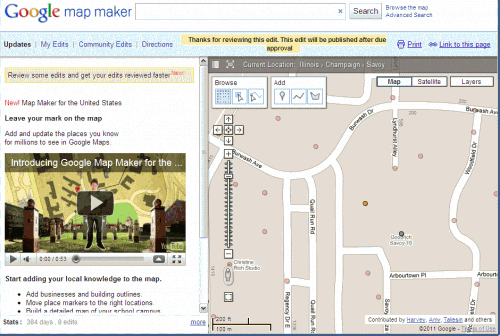It’s time to brush up on those cartography skills. If you’ve ever relied on Google Maps to find some place and was met with the unfortunate surprise that the map was inaccurate, you can rejoice with the fact that Google Map Maker is now available for U.S. locations. Even if the map tells you to look on the wrong side of the street, although Google Street View has helped address that where available, it can be very annoying, frustrating, and time consuming. The same frustrations are true for those of us who check out our neighborhoods or hometowns and *facepalm* at how things are just shifted a few blocks off.
Google Maps previously introduced the ability to edit some objects, more so if you were the owner of the place, but the review process felt like dropping something off in the company Suggestion Box. You never know if or when your recommendation will be implemented or if it will get you fired. Google Map Maker feels like they finally give you all the tools needed to do the job. It also makes the review process up front and an area the community can contribute.
The availability of Google Map Maker for the USA was announced on the Google LatLong blog and cross-posted to the official Google blog. Although critics might say that this approach is only emphasized by Google so much because it allows them to get out of paying mapping companies like Telenav for updated maps, it does make sense to crowd-source local information to the locals. Arguments the other way, however, would say that all these corrections that need to be made and frustrations had with inaccurate maps is in the data bought from those other companies. Perhaps the argument should be that local edits shouldn’t be the only source of information but the tools should be available to correct the bulk imported data.
Making changes to maps is pretty straight-forward. You zoom in, find a place’s dot and drag it to its proper location or click on it to edit the details about it. You can also use the point, line, or polygon tools that you might be familiar with already from the Google My Maps. You can also find more pointers from the Google Map Maker Help Page or the Google Map Maker feature tour.
A fascinating part of Google Map Maker comes from the ability to review others requested edits. Under the Community Edits link, you can see any pending edits in the extent your map is showing. From there, you can see the edits and who made them and then approve or deny them based on your knowledge. You’ll also notice that editors are given credit in the bottom-right of the map for their contributions. If you have the Google Earth plugin in your browser (or even without it – just ignore the prompt), you can go to Google Map Maker Pulse to see map edits being made around the world as they happen. You can also keep track of your edit recommendations to see if they are accepted or not under the My Edits link.
Google may be too late as many of the folks that care enough and are meticulous enough to edit maps regularly have probably gone on to OpenStreetMap.org to edit maps that other sources are coming to rely on. There is also, of course, full on GIS that might appeal to many with overlapping interests of Google Map Maker. This tool has been available to other countries before and is just now being released for the US. Making the tool available to other countries sooner rather than later might allow Google to retain a few of the talented individuals and a number of their visitors that are being frustrated with inaccurate maps.
I recall one of my first impressions with MapQuest involved getting directions to a Chicago suburbs. The directions got us to the city but actually continued to take us to a very specific location – the middle of a residential block in a subdivision that had a sign saying “Welcome to [town name]”. Hopefully maps have gotten smarter since then (as well as the people using them) and hopefully Google Map Maker will be a step in the right direction for Google Maps.


